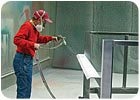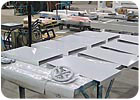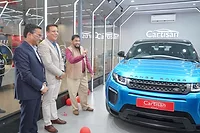State-of-the-Art Waterborne Finishing
In 2000, Black Brothers switched from solvent-based to waterborne coatings, primarily for workplace health and safety. Unfortunately, the initial waterborne coating used was deficient in both appearance quality and production efficiency. Changing to a high-durability waterborne coating has enabled the 125-year-old company to continue its reputation as a state-of-the-art equipment manufacturer.

Today it’s quite common to hear that change is constant, and successful companies regularly reinvent themselves. Actually, that’s a pretty old concept. For proof, take a look at Black Brothers, which is celebrating its 125th birthday this year.
In 1882, five Scottish brothers, who were cabinet makers, came to Chicago and opened a factory. Eight years later, they moved their business to Mendota, IL, outside of Chicago. The first reinvention was about to take place.
In those days, cabinets were assembled by hand. Many hours were spent hand sanding the ornate wood moldings of the era. The enterprising brothers invented and patented a molding sander, which the company sold to the woodworking industry. As other furniture makers learned about the sander, the demand was so strong that the brothers changed direction, and Black Brothers soon became a successful manufacturer of furniture making equipment
By the middle of the 21st century, the company’s product line included coating and laminating equipment, adhesive spreaders, roll coaters, presses and related material handling equipment. Then, U.S. furniture production started to move offshore. As a result, the company, still under the control of members of the founding family, reinvented itself all over again. Today, Black Brothers sells equipment to many other markets that use roll coating, laminating and adhesive spreading machines to produce a range of non-furniture products, including carpet, ceiling tiles, garage doors, automobiles, boats and restaurant equipment.

Management believes that “curb-appeal” is critical and insists that every piece of equipment leaving Mendota reflects its promise of high-quality performance. It also recognizes that long-term appearance is important, regardless of the environment in the customer’s factory. The coating must adhere despite temperature and humidity changes and be able to withstand any solvents, grease or oils with which it might come in contact.
Appearance aside, customers want their equipment as quickly as possible, so every phase of the operation is constantly scrutinized to be certain quality is built in while wasted time is eliminated. As a result, one production step that has undergone changes is the coating process.
The company uses a two-coat, air dry painting process. Large individual frame parts, along with some smaller components, are painted first. Then the entire machine is assembled and repainted to coat hidden, protected surfaces and to cover any scratches or blemishes that might have occurred during assembly.
The coating line’s first customers are its highly skilled assembly experts. Each order is assigned to one expert who assembles the entire machine and accepts “ownership” for its performance. The assembly professionals field customer calls if there is a question about a machine they assembled and even make customer visits if necessary. As a result, they want to be certain that when one of their machines is shipped, it looks its very best and performs as promised.
Because of the tight delivery schedules, extreme importance is placed on drying time for both passes through the paint booth. The climate in Mendota is cold and dry in the winter and hot and humid in the summer. The first coat must dry quickly to permit assembly. The second coat also has to dry quickly so that all operating instruction and safety labels can be affixed before shipment.
In 2000, the plant switched from solvent-based to waterborne coatings, primarily for workplace health and safety. Unfortunately, the initial waterborne coating used was deficient in both appearance quality and production efficiency. It was prone to runs and sags, which required excessive painting time to avoid or correct. Equally if not more important was a highly inconsistent dry time, which might vary by as much as six hours. Certainly a several-hour delay in assembling a finished machine or in putting on all of the required decals and labels placed product delivery schedules at great risk.
In similar situations, it’s normal to examine the extent to which the painting process itself could cause these issues. Black Brothers was fortunate to have a paint booth operator with more than 30 years of experience. However, while her extensive review of the painting procedure led to some alterations in the application process and the equipment, no significant improvement was forthcoming.

Finishes Unlimited brought to the assignment many years of experience formulating air-dry coatings and evaluating paint line operations located in areas with shifting climates. With U.S. manufacturers relying on quick customer delivery as a competitive edge, the need to achieve quick drying times is a constant request. The ability to meet these demands requires a careful orchestration of paint formulation, paint line procedures and drying area operations.
In Black Brother’s case, Finishes Unlimited’s lab technicians set about to eliminate the sags and runs that were appearing while delivering a one-hour dry time for both components and completed machines. They first reviewed the variety of metal surfaces and component shapes and sizes to be painted, along with the changing temperature and humidity conditions and tight production schedules prevalent in Mendota. This review led to the creation, testing and modification of its basic air-dry coating formula.
One goal was to allow the application of a second coat of paint at any time without worrying about a recoat window. Some coatings require that a second coat be applied within a certain time limit to avoid a risk of surface wrinkling. Such time constraints would be unacceptable at Black Brothers, where painted components might wait an hour, overnight or over the weekend before the machine is assembled and sent back to the paint booth.
Fighting sags and running is both a formulation and application process. While these blemishes can appear on any part of the surface, they frequently occur when a hidden, cut out or other difficult-to-reach area is being painted and excess paint builds up and runs on nearby surfaces. Formulation changes resolved a portion of this problem, and working with the paint line operator to slightly change how this new coating was applied led to a complete solution.
Another important asset required of the new coating was a strong initial adhesion. Once a finished machine is dry, it’s ready for the application of instructional and safety labels. Should one of these labels need to be removed or replaced for any reason, it can be peeled away without marring the surface and requiring touch-up painting.
In order to take advantage of the quick drying characteristics of the new coating formulation, Finishes Unlimited also suggested making airflow changes in the portion of the plant where painted components and finished machines were taken to dry. As a result, the average drying time for any painted surface is approximately one hour year round.

Additionally, when the conversion project was started, all machines were painted in a two-tone teal-and-white color scheme, and the surfaces of all safety and protective components were painted orange. Now the company paints its machines white only with protective components still painted orange. The switch was made because any spatter or spray resulting from operator, process or raw material deficiencies will show up quickly on the white surface. On occasion, a customer will request a custom color, which Finishes Unlimited can create using the same basic formula that still dries quickly and provides the same efficient surface coverage.
For more information about Finishes Unlimited, visit www.finishesunlimited.com.
For more information about Black Brothers, visit www.blackbros.com.

A machine frame is painted prior to assembly.
Today it’s quite common to hear that change is constant, and successful companies regularly reinvent themselves. Actually, that’s a pretty old concept. For proof, take a look at Black Brothers, which is celebrating its 125th birthday this year.
In 1882, five Scottish brothers, who were cabinet makers, came to Chicago and opened a factory. Eight years later, they moved their business to Mendota, IL, outside of Chicago. The first reinvention was about to take place.
In those days, cabinets were assembled by hand. Many hours were spent hand sanding the ornate wood moldings of the era. The enterprising brothers invented and patented a molding sander, which the company sold to the woodworking industry. As other furniture makers learned about the sander, the demand was so strong that the brothers changed direction, and Black Brothers soon became a successful manufacturer of furniture making equipment
By the middle of the 21st century, the company’s product line included coating and laminating equipment, adhesive spreaders, roll coaters, presses and related material handling equipment. Then, U.S. furniture production started to move offshore. As a result, the company, still under the control of members of the founding family, reinvented itself all over again. Today, Black Brothers sells equipment to many other markets that use roll coating, laminating and adhesive spreading machines to produce a range of non-furniture products, including carpet, ceiling tiles, garage doors, automobiles, boats and restaurant equipment.

Prepainted machine components are air-dried before the final assembly process.
Coating Requirements
So where do coatings fit into this American business success story?Management believes that “curb-appeal” is critical and insists that every piece of equipment leaving Mendota reflects its promise of high-quality performance. It also recognizes that long-term appearance is important, regardless of the environment in the customer’s factory. The coating must adhere despite temperature and humidity changes and be able to withstand any solvents, grease or oils with which it might come in contact.
Appearance aside, customers want their equipment as quickly as possible, so every phase of the operation is constantly scrutinized to be certain quality is built in while wasted time is eliminated. As a result, one production step that has undergone changes is the coating process.
The company uses a two-coat, air dry painting process. Large individual frame parts, along with some smaller components, are painted first. Then the entire machine is assembled and repainted to coat hidden, protected surfaces and to cover any scratches or blemishes that might have occurred during assembly.
The coating line’s first customers are its highly skilled assembly experts. Each order is assigned to one expert who assembles the entire machine and accepts “ownership” for its performance. The assembly professionals field customer calls if there is a question about a machine they assembled and even make customer visits if necessary. As a result, they want to be certain that when one of their machines is shipped, it looks its very best and performs as promised.
Because of the tight delivery schedules, extreme importance is placed on drying time for both passes through the paint booth. The climate in Mendota is cold and dry in the winter and hot and humid in the summer. The first coat must dry quickly to permit assembly. The second coat also has to dry quickly so that all operating instruction and safety labels can be affixed before shipment.
In 2000, the plant switched from solvent-based to waterborne coatings, primarily for workplace health and safety. Unfortunately, the initial waterborne coating used was deficient in both appearance quality and production efficiency. It was prone to runs and sags, which required excessive painting time to avoid or correct. Equally if not more important was a highly inconsistent dry time, which might vary by as much as six hours. Certainly a several-hour delay in assembling a finished machine or in putting on all of the required decals and labels placed product delivery schedules at great risk.
In similar situations, it’s normal to examine the extent to which the painting process itself could cause these issues. Black Brothers was fortunate to have a paint booth operator with more than 30 years of experience. However, while her extensive review of the painting procedure led to some alterations in the application process and the equipment, no significant improvement was forthcoming.

A machine is assembled after the major components have been painted. The finish must be completely dry before the final assembly step is initiated.
Increasing Quality and Productivity
In 2005 the company decided to search for another coating supplier whose products were capable of delivering both the finish and drying time consistency that were necessary. Finishes Unlimited, a waterborne coating company headquartered in Sugar Grove, IL, was invited to be considered.Finishes Unlimited brought to the assignment many years of experience formulating air-dry coatings and evaluating paint line operations located in areas with shifting climates. With U.S. manufacturers relying on quick customer delivery as a competitive edge, the need to achieve quick drying times is a constant request. The ability to meet these demands requires a careful orchestration of paint formulation, paint line procedures and drying area operations.
In Black Brother’s case, Finishes Unlimited’s lab technicians set about to eliminate the sags and runs that were appearing while delivering a one-hour dry time for both components and completed machines. They first reviewed the variety of metal surfaces and component shapes and sizes to be painted, along with the changing temperature and humidity conditions and tight production schedules prevalent in Mendota. This review led to the creation, testing and modification of its basic air-dry coating formula.
One goal was to allow the application of a second coat of paint at any time without worrying about a recoat window. Some coatings require that a second coat be applied within a certain time limit to avoid a risk of surface wrinkling. Such time constraints would be unacceptable at Black Brothers, where painted components might wait an hour, overnight or over the weekend before the machine is assembled and sent back to the paint booth.
Fighting sags and running is both a formulation and application process. While these blemishes can appear on any part of the surface, they frequently occur when a hidden, cut out or other difficult-to-reach area is being painted and excess paint builds up and runs on nearby surfaces. Formulation changes resolved a portion of this problem, and working with the paint line operator to slightly change how this new coating was applied led to a complete solution.
Another important asset required of the new coating was a strong initial adhesion. Once a finished machine is dry, it’s ready for the application of instructional and safety labels. Should one of these labels need to be removed or replaced for any reason, it can be peeled away without marring the surface and requiring touch-up painting.
In order to take advantage of the quick drying characteristics of the new coating formulation, Finishes Unlimited also suggested making airflow changes in the portion of the plant where painted components and finished machines were taken to dry. As a result, the average drying time for any painted surface is approximately one hour year round.

All of Black Brothers’ machines must look their best and perform as promised.
Additional Advantages
Other, unanticipated advantages accrued to Black Brothers as well. With the new coating and application adjustments, transfer efficiency was increased, meaning that more surface coverage is now achieved with less paint.Additionally, when the conversion project was started, all machines were painted in a two-tone teal-and-white color scheme, and the surfaces of all safety and protective components were painted orange. Now the company paints its machines white only with protective components still painted orange. The switch was made because any spatter or spray resulting from operator, process or raw material deficiencies will show up quickly on the white surface. On occasion, a customer will request a custom color, which Finishes Unlimited can create using the same basic formula that still dries quickly and provides the same efficient surface coverage.
For more information about Finishes Unlimited, visit www.finishesunlimited.com.
For more information about Black Brothers, visit www.blackbros.com.
Looking for a reprint of this article?
From high-res PDFs to custom plaques, order your copy today!





